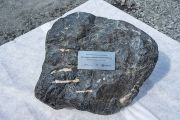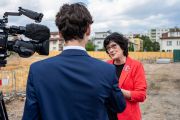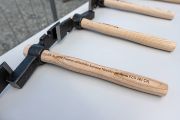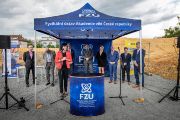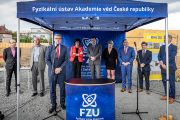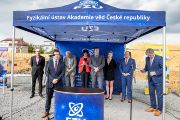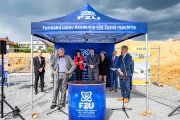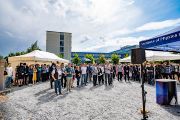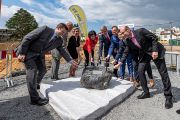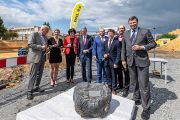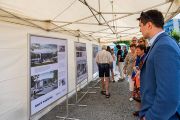
A top centre for solid state physics research to be built in Ládví in two years
20. 08. 2019
Understanding processes in modern materials and nanostructures and developing new materials, components and applications for various areas of technology, power engineering and medicine – these will be the goals of a new research centre whose construction has just begun in the premises of the Institute of Physics of the Czech Academy of Sciences (FZU CAS) in Prague 8 – Ládví. On 14 August 2019, the foundation stone has been laid in the presence of significant personalities of Czech science and politics, including the President of the Czech Academy of Sciences Eva Zažímalová, Vice President of the Czech Academy of Sciences Jan Řídký, Minister of Industry and Trade Karel Havlíček, Deputy Minister of Education, Youth and Sports Václav Velčovský, representative of the European Commission Josef Schwarz, and Director of the FZU Michael Prouza.
The building has been designed at a well-known studio Bogle Architects which has already participated in designing the building of the ELI Beamlines Centre in Dolní Břežany, which gained several awards in architecture competitions, e.g. the first place in Grand Prix in a new building category.
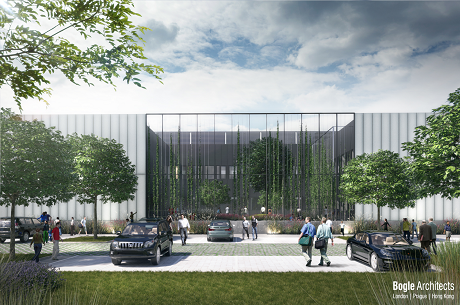
The building has been designed by Bogle Architects
At the new centre, successful FZU scientific teams, which deal with current scientific and technical challenges of the 21st century in the fields of nanoelectronics, photonics, magnetism, functional and bioactive materials and plasma technologies, will join forces. The new building, consisting of two aboveground floors plus the basement, will be able to house up to 30 laboratories. It will be maximally adapted to the demands of extremely sensitive instruments and studied materials. Each laboratory will be accommodated to its respective purpose. For example, the space for work with UV sensitive materials has to be equipped with yellow lighting and on the windows yellow filters will be installed. For the purpose of vibration minimization, the laboratories will be located on the ground floor or in the basement.
“We are eagerly waiting for the construction to be finished,” said Michael Prouza, the director of the FZU, just before the ceremonial tapping on the foundation stone. “It is absolutely necessary to have top equipment for solid particles, a scientific field dealt with by more than a half of the researchers at the Institute of Physics. We have excellent scientists, whose outputs are promptly recognised by the most prestigious journals, and we are obliged to provide them with suitable conditions,” emphasised the director of the largest institute of the Czech Academy of Sciences.
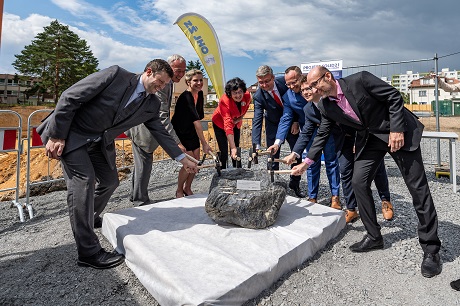
Foundation stone laying ceremony. Left to right: Michal Prouza, Jan Řídký, Viktorie
Součková, Eva Zažímalová, Karel Havlíček, Václav Velčovský, Josef Schwarz, Aleš Kézr
The expected cost of the construction is nearly 290 million CZK (11 million EUR), of which 180 million CZK will be paid from the European Union’s Operational Programme Research, Development and Education. The rest will be financed from the budget of the Czech Academy of Sciences. The building is planned to be completed in March 2021.
The building is a part of SOLID21 (Solid State Physics for 21st Century) project, which has been supported by more than half a billion CZK from the Operational Programme Research, Development and Education. FZU has been working on the programme since 2018, with participation of more than 200 researchers.
Solid state physics in everyday life
“We are greatly delighted to see that one of the institutes of the Academy of Sciences has been involved in a project with sufficient funds to cover the construction of the new building as well as, to a large extent, its instrumental equipment,” said Eva Zažímalová, the President of the Czech Academy of Sciences, introducing the ceremonial act attended by the employees of the FZU and their colleagues from the neighbouring institutes. She spoke about a long tradition and significant successes in the area of solid state physics. She also mentioned the fact that from this very scientific area, groundbreaking innovations such as transistors, lasers, photovoltaic cells, or LED lights have arisen, influencing our everyday life.
The significance of basic research for the development of society as a whole was emphasised by Karel Havlíček, the Minister of Industry and Commerce. “If we wish to achieve the ambitions identified in the Innovation Strategy by 2030, we need to invest now already, I would even say ‘crazily’ invest, into research, science and innovation,” summed up the minister. “It is necessary to start with the fields we are strong at, physics being one of them, and the Institute of Physics has been – without question – the carrier of the success of Czech science in the field of physics,” said the minister – who is also a vice president of the government’s Council for Research, Development and Innovation – paying a compliment not only to the scientists present at the ceremony.
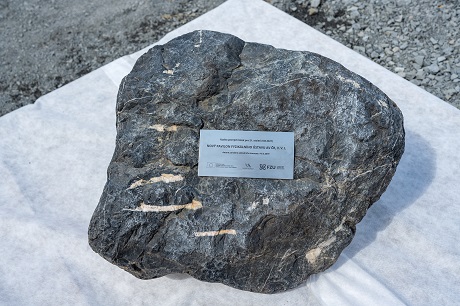
The new building’s foundation stone from the nearby hill Ládví
The perspective for the development of the Institute of Physics in the key scientific area – in association with the construction of the new building – was also pointed out by Jan Řídký who was, as a former director of the Institute, the first initiator of the existing SOLID21 project. “I invited my colleagues to discuss this topic for the first time on 15 July 2015. At that time, HILASE was practically finished, and ELI was at an advanced state of completion,” said the vice president of the Academy of Sciences to recall the very beginning of the project, which is expected to produce a top research centre in two years’ time.
The foundation stone is made up of the so-called touchstone, a flint of dark colour, which by its hardness symbolises the demanding nature of solid state physics. The origin of the stone also refers to the connection of the Institute of Physics with Prague 8 – the stone comes from the nearby hill Ládví where it was mined for the production of primitive stone tools already in prehistoric times. The foundation stone’s laying ceremony was also attended by Josef Schwarz from the European Commission, Viktorie Součková from Bogle Architects, and Aleš Kézr from the construction company.
Original Czech text prepared by: Markéta Růžičková, Department of Media Communication of the CAS, in cooperation with Míla Moudrá, Institute of Physics of the CAS
Photo: Bogle Architects, Mirek Bednařík
Read also
- Public Hearing: “Making Sense of Open Science”
- SUNER-C concludes after three years dedicated to the renewable energy future
- A trapped state: The pandemic impact on public attitudes, trust, and behavior
- Aerial archaeology: Tracing the footsteps of our ancestors from the sky
- Archaeologists uncover ancient finds along Prague Ring Road
- Our microbiome largely depends on what we eat, says microbiologist Michal Kraus
- The ABCs of writing: Why did its invention mark a turning point for humankind?
- We learn, remember, forget… What can memory actually do? And can we outsmart it?
- New Center for Electron Microscopy in Brno opens its doors to global science
- The hidden lives of waste: What can we learn from waste workers and pickers?
The Czech Academy of Sciences (the CAS)
The mission of the CAS
The primary mission of the CAS is to conduct research in a broad spectrum of natural, technical and social sciences as well as humanities. This research aims to advance progress of scientific knowledge at the international level, considering, however, the specific needs of the Czech society and the national culture.
President of the CAS
Prof. Eva Zažímalová has started her second term of office in May 2021. She is a respected scientist, and a Professor of Plant Anatomy and Physiology.
She is also a part of GCSA of the EU.
